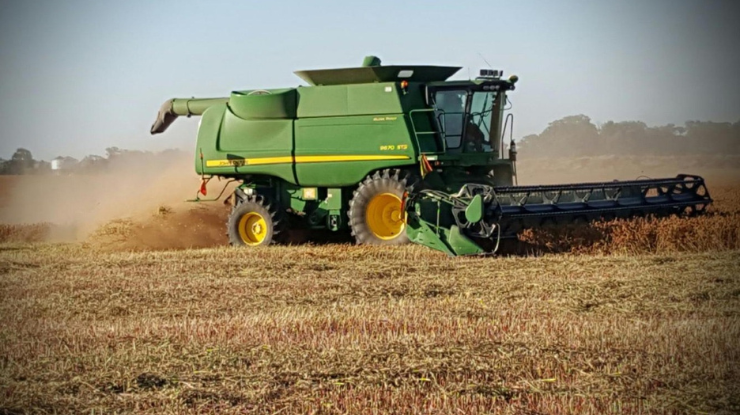 Harvesting arrowleaf clover at the Rodhams’ NSW property. Image: Craig Rodham
Harvesting arrowleaf clover at the Rodhams’ NSW property. Image: Craig Rodham
Trialling legumes to boost pastures and profit
NSW producers Craig and Kath Rodham traditionally run a winter cropping program of wheat, canola and barley alongside their crossbred flock of 4,800 ewes, but changes are underway to develop a more flexible farming system better suited to climatic challenges.
The Rodhams have begun introducing hard-seeded pasture legumes – including arrowleaf, bladder and balansa clovers – to reduce risk, utilise weed and pest control options, and take advantage of livestock trading opportunities.
The seed crops are grown and harvested (using a conventional header) as part of a pasture renovation program to reduce pasture establishment costs while increasing stocking rates and feed ability.
Here’s a closer look at how they incorporate cropping into their enterprise.
Arrowleaf clover
The Rodhams generally sow arrowleaf clover as unprocessed seed (seed that has been header harvested and remains unscarified) in late summer with ALOSCA granules.
Sowing in late summer means temperature fluctuations can break down a proportion of the hard seed, allowing the pasture to emerge on opening season rainfall and produce a large bulk of feed before temperatures drop in winter.
In winter, the arrowleaf is grazed strategically and then locked up for hay production, where rapid recovery from grazing results in hay yield averaging 6t DM/ha.
Fodder conservation assists in controlling herbicide-resistant ryegrass – which can be problematic in following crops – by cutting and removing it before the seed is formed.
The combination of higher feed availability early in the season and capacity to undertake fodder conservation significantly reduces supplementary feed costs.
Bladder clover
Like arrowleaf, bladder clover is being incorporated into the Rodhams’ cropping rotation.
The bladder clover is summer sown, grazed strategically and allowed to set seed.
In the following year it’s cropped with the previous year’s legume, significantly reducing nitrogen fertiliser input requirements for the crop.
The legume then regenerates in the third year.
“The rotation appears to have good potential in our farming system, providing high quality feed for the sheep and reducing our crop input costs,” Craig said.
Both bladder and arrowleaf clover are also used in combination with lucerne for longer term pasture phases.
The annual legumes significantly increase winter feed availability compared to lucerne-only stands and contribute to higher ground cover in summer.
Vetch
Vetch plays a key role in the Rodhams’ farming system. They grow it strategically in combination with oats for silage and hay production, especially in paddocks where there is a need to reduce weed burdens before going back into crop.
“The vetch–oat mix is a very useful tool, especially when there is a late autumn break or there hasn’t been an opportunity to get a number of weed knockdowns on a paddock prior to sowing,” Craig said.
Seeing their pastures with new eyes, ryegrass – which was once viewed as a weed in their crops – is now recognised as a quality feed source.
“This mix is competitive against weeds – any ryegrass that does come through contributes to the production of a high quality silage or hay product that we can then use to fill seasonal feed gaps or sell,” Craig said.
“It also does a great job of reducing the weed burden going into the next crop.”
On-farm results
After introducing legumes into their farming system, the Rodhams reduced the area of canola in their cropping program from around 300ha to 75ha.
“Canola was a riskier crop for us with the prevalence of frost damage we experience,” Craig said.
In scaling back canola and introducing legumes, the Rodhams concurrently lifted their ewe numbers from 3,000 to 4,800.
“We’ve achieved a long-term marking average of 125% and with the higher quality pastures, silage and hay, we can finish all our lambs and in dry time retain our ewe numbers.”
The Rodhams also now trade about 200 head of cattle per year.
“We buy them in at around 250–300kg liveweight and feed them for 90 days. This was something we couldn’t do reliably before having increased our legume component in our farming system,” Craig said.
This year, the Rodhams are continuing their pasture renovation journey, trialling Carn2ac Trigonella, and have planted 12ha as a seed block.
“We’re interested to see how trigonella performs in our area. It appears to establish quickly and we’re keen to see how hardy it is, how easy it is to harvest seed and what it yields,” Craig said.
“Ultimately, we’re looking to see how we can use it in our system either as a standalone pasture or in combination with lucerne.”



